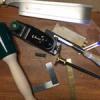I'm working with red oak.
I only have stanley sw 750 bevel edge chisels. Chisels are sharp, er, at least as sharp as I can get them with my current skill level of sharpening (honing guide, 1000/8000/strop).
Photo Aug 17, 9 36 03 PM.jpgPhoto Aug 17, 9 36 27 PM.jpg
The mortise is drawn by placing the ~ 1.25" x 0.5" tenon in the center and drawing/knifing the outline.
I've tried three methods for chopping the mortise.
Method 1: 1" chisel along the long side, in the knife line, hit it a little, then come back at a 45 towards the edge and knock out the waste. then work it deeper. Use 1/2" chisel on the short side. Basically making the trough around each of the 4 edges deeper and wider.
Method 2: First drill out three 3/8" holes to remove most of the waste. Then work back towards the line instead of working directly on it for all 4 edges.
Method 3: Paul Sellers cutting a mortise with a bevel edge chisel video: https://www.youtube.com/watch?v=q_NXq7_TILA
Problems I've encountered:
Method 1: Takes a long time. The cuts along the long edge, that are in the direction of the grain are not clean at all, and I tend to get splinters that shear off if that makes sense.
Method 2: Faster but my lines aren't as clean. Same splintering problem on the long edges.
Method 3: Faster still. Only used a 1/2" chisel but my wood ended up splitting and cracking right down the middle once I got close to finishing. Too much leverage I'm guessing.
For all three methods I can only work from one side as I do not have an accurate way to trace the tenon on both sides of the work piece.
So, given the grain, is there a recommended method?





 Reply With Quote
Reply With Quote




